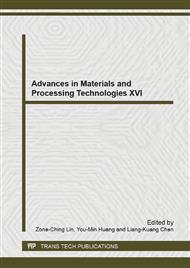p.39
p.47
p.53
p.60
p.68
p.76
p.84
p.90
p.98
New Design of Aluminium Based Composites through Combined Method of Powder Metallurgy and Thixoforming
Abstract:
The present study deals with a new design of aluminium alloy based composites reinforced with SiC particles and Si/Al2O3 powders through combined methods of powder metallurgy and thixoforming. Moreover, recycled machining chips are used as raw material, specifically AA7075 chips generated in the aeronautical industry. The proposed method is based on forming at high temperatures a compacted mixture of metal chips and reinforcing particles, with the metal in thixotropic semi-solid condition. Composites containing different SiC weight fractions (10, 20 and 30%) were produced and had their microstructure analyzed. Mechanical properties were evaluated by means of micro-indentation tests. General results show the feasibility of producing composites by the proposed route. Products with good mechanical properties could be obtained. The process, even still not completely optimized as some improvement still must be achieved, can bring a new possibility for the production of a noble material from recycled wastes, particularly important in the high energy spending Al industries.
Info:
Periodical:
Pages:
68-75
Citation:
Online since:
May 2014
Keywords:
Price:
Сopyright:
© 2014 Trans Tech Publications Ltd. All Rights Reserved
Share:
Citation:


